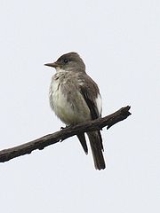
Olive-sided Flycatcher
Encyclopedia
The Olive-sided Flycatcher, Contopus cooperi, is a passerine
bird
. It is a medium-sized tyrant flycatcher
.
The song is a whistled quick-three beers. The call is a rapid pip pip pip.
, Alaska
and the northeastern and western United States
, and other types of wooded area in California
. Olive-sided Flycatchers are abundant in early postfire landscapes that have burned at high severity.
These birds migrate
to Central America
and the Andes
region of South America
.
s in flight.
in its winter range.
Passerine
A passerine is a bird of the order Passeriformes, which includes more than half of all bird species. Sometimes known as perching birds or, less accurately, as songbirds, the passerines form one of the most diverse terrestrial vertebrate orders: with over 5,000 identified species, it has roughly...
bird
Bird
Birds are feathered, winged, bipedal, endothermic , egg-laying, vertebrate animals. Around 10,000 living species and 188 families makes them the most speciose class of tetrapod vertebrates. They inhabit ecosystems across the globe, from the Arctic to the Antarctic. Extant birds range in size from...
. It is a medium-sized tyrant flycatcher
Tyrant flycatcher
The tyrant flycatchers are a family of passerine birds which occur throughout North and South America. They are considered the largest family of birds on Earth, with more than 400 species. They are the most diverse avian family in every country in the Americas, except for the United States and...
.
Description
Adults are dark olive on the face, upperparts and flanks. They have light underparts, a large dark bill and a short tail.The song is a whistled quick-three beers. The call is a rapid pip pip pip.
Systematics
Contopus borealis is a junior synonym of Contopus cooperi, according to the 1997 AOU checklist, quoted by BISON. The name of this species is listed as Contopus borealis in many older guides.Distribution and habitat
Their breeding habitat is coniferous woods across CanadaCanada
Canada is a North American country consisting of ten provinces and three territories. Located in the northern part of the continent, it extends from the Atlantic Ocean in the east to the Pacific Ocean in the west, and northward into the Arctic Ocean...
, Alaska
Alaska
Alaska is the largest state in the United States by area. It is situated in the northwest extremity of the North American continent, with Canada to the east, the Arctic Ocean to the north, and the Pacific Ocean to the west and south, with Russia further west across the Bering Strait...
and the northeastern and western United States
United States
The United States of America is a federal constitutional republic comprising fifty states and a federal district...
, and other types of wooded area in California
California
California is a state located on the West Coast of the United States. It is by far the most populous U.S. state, and the third-largest by land area...
. Olive-sided Flycatchers are abundant in early postfire landscapes that have burned at high severity.
These birds migrate
Bird migration
Bird migration is the regular seasonal journey undertaken by many species of birds. Bird movements include those made in response to changes in food availability, habitat or weather. Sometimes, journeys are not termed "true migration" because they are irregular or in only one direction...
to Central America
Central America
Central America is the central geographic region of the Americas. It is the southernmost, isthmian portion of the North American continent, which connects with South America on the southeast. When considered part of the unified continental model, it is considered a subcontinent...
and the Andes
Andes
The Andes is the world's longest continental mountain range. It is a continual range of highlands along the western coast of South America. This range is about long, about to wide , and of an average height of about .Along its length, the Andes is split into several ranges, which are separated...
region of South America
South America
South America is a continent situated in the Western Hemisphere, mostly in the Southern Hemisphere, with a relatively small portion in the Northern Hemisphere. The continent is also considered a subcontinent of the Americas. It is bordered on the west by the Pacific Ocean and on the north and east...
.
Feeding
They wait on a perch at the top of a tree and fly out to catch insectInsect
Insects are a class of living creatures within the arthropods that have a chitinous exoskeleton, a three-part body , three pairs of jointed legs, compound eyes, and two antennae...
s in flight.
Breeding
The female usually lays 3 eggs in a shallow open cup nest on a horizontal tree branch. The male defends a large area around the nesting territory. Both parents feed the young birds.Status and conservation
The numbers of this bird are declining, probably due to loss of habitatHabitat (ecology)
A habitat is an ecological or environmental area that is inhabited by a particular species of animal, plant or other type of organism...
in its winter range.
Further reading
- Willis, E.O.; Snow, D.W.; Stotz, D.F. & Parker III, T.A. (1993) Olive-sided Flycatchers in Southeastern Brazil Wilson Bulletin 105(1):
External links
- Olive-sided Flycatcher - Contopus cooperi - USGS Patuxent Bird Identification InfoCenter
- Olive-sided Flycatcher Species Account - Cornell Lab of Ornithology
- Olive-sided Flycatcher Information - South Dakota Birds and Birding

